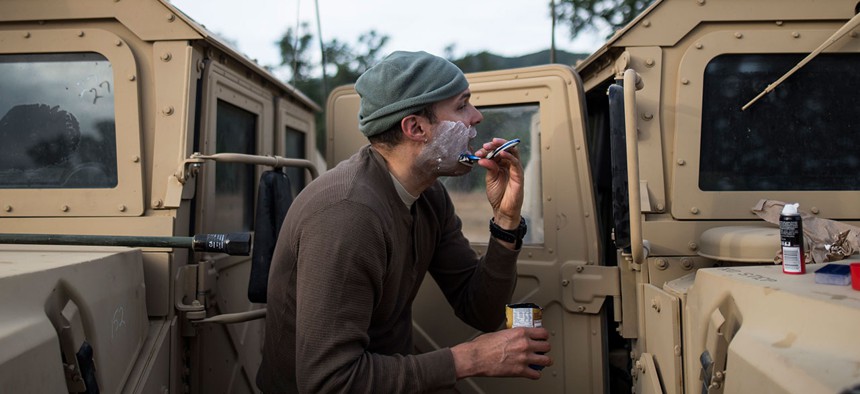Coming Soon to the U.S. Army: Turbans, Beards, Hijabs, and Dreadlocks
In the final days of the Obama administration, the military has issued new guidelines for religious accommodations and dress.
The Army has issued a new regulation: Effective immediately, brigade-level commanders will be able to grant accommodations to servicemen and women who wear beards, turbans, or hijabs for religious reasons—the three most common requests for waivers to current guidelines on grooming and dress, according to a letter from the Secretary of the Army, Eric Fanning. The new guidelines also revise hairstyle standards for female soldiers: They can now wear dreadlocks in addition to cornrows and twists, which were allowed in a revision made in 2014. Like other hairstyles, locks must be relatively small, uniform, neat, and tied off inconspicuously, and women don’t have to request an accommodation to wear them.
This might seem like an odd choice for a policy directive in the final days of the Obama administration. It came about largely in response to litigation and advocacy from Sikh servicemen who wear beards and turbans for religious reasons, and who wanted to be able to keep them while actively serving. While this ruling will make a big difference for those soldiers, there are very few of them. Eric Baxter, an attorney at the Becket Fund for Religious Liberty, one of the firms that has been advocating on behalf of the Sikh soldiers, attributed the timing to fear of continued litigation. “The pressure of the lawsuit was a significant factor in deciding this needs to be finished,” he said. “The time had just come when it was no longer possible to make excuses for why Sikhs need to be excluded.”
It’s possible that the Army felt it had no options and wanted to put the issue to rest, but also possible the directive reflects some other unstated motive. Regardless of the intent, though, this regulation sends a signal: It makes the Army more inclusive of minority religions and cultures, right as Donald Trump prepares to take office.
The new regulations are a response to a long-standing issue within the military. In the 1986, the Supreme Court heard a case brought by an Orthodox Jewish rabbi, Simcha Goldman, who had been forbidden by the Air Force to wear a yarmulke while on duty and in uniform. The Court deferred to the military. In response, Congress passed a rule stating that servicemen should be able to wear religious apparel. “When you look at the legislative history for that law, Congress spoke openly about the need to accommodate Sikhs and Jews,” said Baxter. “But the military has always construed it as only applying to the yarmulke.”
Over the years, military officers have regularly dealt with requests for religious exemptions to various rules. Douglas Carver, a Southern Baptist minister who is the former chief chaplain for the Army, said he faced his first religious exemption requests almost as soon as he became a chaplain. When he retired from service in 2011, the conversation about a possible dress-code revision had already been happening for years, he said. “The military is strong on tradition and order. When you’re going to have someone who looks different in the ranks, it takes a lot of discussion and exploration and advisement.”
Recently, Sikhs have taken up the cause. Within the last year, several serviceman have sued the Army to be able to keep their turbans and beards. Until now, the Army has responded with temporary fixes—exemptions granted on a limited, case-by-case basis. The military expressed safety concerns about the way beards or other headwear might undermine the effectiveness of gear, and began conducting studies about the feasibility of broader exemptions.
Over time, these exemptions provided evidence that soldiers could successfully serve while wearing non-standard dress, according to Fanning’s letter. Now, officers across the military will be able to address requests for religious exemptions with the guidance of the Chaplain Corps, which is responsible for training service units on the new rules. Once an accommodation has been granted, it can only be permanently revoked by the secretary of the Army or his designee. The military will also continue testing for safety hazards; for now, soldiers with religious accommodations are restricted from serving in positions involving toxic chemicals and other potentially dangerous substances.
Carver sees the new regulation as an accomplishment for the Army. Faith is a major part of many service members’ lives; religious affiliation is even listed on soldiers’ dog tags, he pointed out. “You are prepared to go into harm’s way, even to die, and practice of your religious belief brings courage and calmness,” he said. “A soldier should not have to feel that he’s about to give his life for his country, but that he doesn’t want to compromise his individual faith or practices.”
The new policy seems to be in keeping with other military policies set during the Obama administration. In June, Secretary of Defense Ash Carter announced a new policy allowing transgender service members to serve openly. “We can’t allow barriers unrelated to a person’s qualifications prevent us from recruiting and retaining those who can best accomplish the mission,” he said. The new regulations on religious dress and hairstyles address a different issue, but they still accomplish the same basic goal: They make the largest branch of the military more inclusive, and allow more Americans to serve their country.



